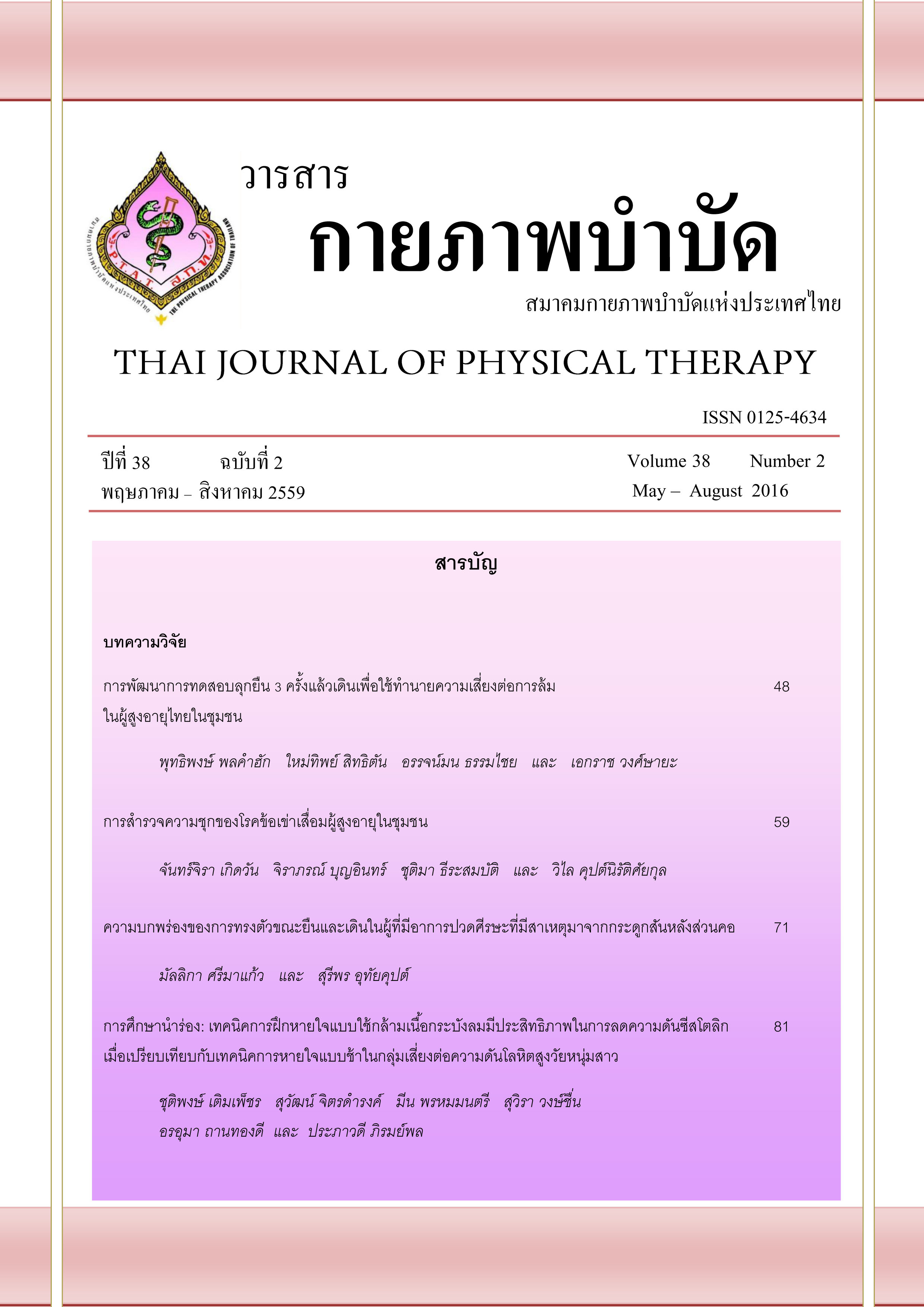ความบกพร่องของการทรงตัวขณะยืนและเดินในผู้ที่มีอาการปวดศีรษะ ที่มีสาเหตุมาจากกระดูกสันหลังส่วนคอ
Main Article Content
บทคัดย่อ
ที่มาและความสำคัญ: หลักฐานงานวิจัยที่ผ่านมาพบว่าความผิดปกติของข้อมูลจากตัวรับความรู้สึกเชิงกลบริเวณกระดูกสันหลังส่วนคอส่งผลต่อความบกพร่องของความสามารถในการทรงตัวขณะยืนและเดินในผู้ที่มีอาการปวดคอ ยังไม่มีการศึกษาใดที่ศึกษาถึงความบกพร่องของการทรงตัวในผู้ที่มีอาการปวดศีรษะที่มีสาเหตุมาจากกระดูกสันหลังส่วนคอ (cervicogenic headache)
วัตถุประสงค์: เพื่อศึกษาความบกพร่องของการทรงตัวขณะยืนและเดินในผู้ที่มีอาการปวดศีรษะแบบ cervicogenic เปรียบเทียบกับกลุ่มควบคุมที่มีสุขภาพดี
วิธีการ: อาสาสมัครประกอบด้วยผู้ที่มีอายุระหว่าง 18-59 ปีที่มีอาการปวดศีรษะแบบ cervicogenic จำนวน 20 คน และกลุ่มควบคุมสุขภาพดีที่มีเพศและช่วงอายุเดียวกันจำนวน 20 คน การทดสอบการทรงตัวขณะยืนประเมินโดยใช้ swaymeter ภายใต้ 4 เงื่อนไข: ขณะยืนปกติบนพื้นราบแข็ง-พื้นนุ่ม ลืมตา-หลับตา แต่ละเงื่อนไขทดสอบเป็นระยะเวลา 30 วินาที การทดสอบการทรงตัวขณะเดินประเมินโดยใช้ 10 Meter Walk Test ภายใต้เงื่อนไขเดินปกติและเดินต่อเท้า
ผลการศึกษา: กลุ่มที่มีอาการปวดศีรษะแบบ cervicogenic มีค่าเฉลี่ยพื้นที่ของการโอนเอียงของลำตัวขณะยืนลืมตาบนพื้นนุ่มมากกว่ากลุ่มควบคุมอย่างมีนัยสำคัญทางสถิติ (p=0.03) ค่าเฉลี่ยพื้นที่การโอนเอียงของลำตัวขณะยืนหลับตาบนพื้นนุ่มมีแนวโน้มเพิ่มมากขึ้นในกลุ่มที่มีอาการปวดศีรษะ (p=0.067) ไม่พบความแตกต่างระหว่างกลุ่มขณะยืน ลืม-หลับตาบนพื้นราบแข็ง (p>0.05) กลุ่มที่มีอาการปวดศีรษะมีอัตราเร็วในการเดินขณะเดินต่อเท้าช้ากว่ากลุ่มควบคุมอย่างมีนัยสำคัญทางสถิติ (p=0.001) ไม่พบความแตกต่างของอัตราเร็วขณะเดินปกติและจำนวนความผิดพลาดขณะเดินต่อเท้าระหว่างกลุ่ม (p>0.05)
สรุปการศึกษา: การศึกษาในครั้งนี้แสดงให้เห็นว่าผู้ที่มีอาการปวดศีรษะแบบ cervicogenic มีความบกพร่องของการทรงตัวขณะยืนและเดิน แต่ความบกพร่องของการทรงตัวขึ้นอยู่กับเงื่อนไขที่ใช้ในการทดสอบ
Article Details
เอกสารอ้างอิง
2. Ambrose AF, Paul G, Hausdorff JM. Risk factors for falls among older adults: a review of the literature. Maturitas 2013; 75: 51-61.
3. Salzman B. Gait and balance disorders in older adults. Am Fam Physician 2010; 82: 61-8.
4. Homann B, Plaschg A, Grundner M, et al. The impact of neurological disorders on the risk for falls in the community dwelling elderly: a case-controlled study. BMJ open 2013; 3: e003367.
5. Gill-Body KM, Beninato M, Krebs DE. Relationship among balance impairments, functional performance, and disability in people with peripheral vestibular hypofunction. Phys Ther 2000; 80: 748-58.
6. Sohn MK, Lee SS, Song HT. Effects of acute low back pain on postural control. Ann Rehabil Med 2013; 37: 17-25.
7. Sjostrom H, Allum JH, Carpenter MG, Adkin AL, Honegger F, Ettlin T. Trunk sway measures of postural stability during clinical balance tests in patients with chronic whiplash injury symptoms. Spine 2003; 28: 1725-34.
8. Poole E, Treleaven J, Jull G. The influence of neck pain on balance and gait parameters in community-dwelling elders. Man Ther 2008; 13: 317-24.
9. Field S, Treleaven J, Jull G. Standing balance: a comparison between idiopathic and whiplash-induced neck pain. Man Ther 2008; 13: 183-91.
10. Uthaikhup S, Sunkarat S, Khamsaen K, Meeyan K, Treleaven J. The effects of head movement and walking speed on gait parameters in patients with chronic neck pain. Man Ther 2014; 19: 137-41.
11. Treleaven J. Sensorimotor disturbances in neck disorders affecting postural stability, head and eye movement control. Man Ther 2008; 13: 2-11.
12. Bogduk N. Cervicogenic headache: anatomic basis and pathophysiologic mechanisms. Curr Pain Headache Rep 2001; 5: 382-6.
13. Sjaastad O, Fredriksen TA, Pfaffenrath V. Cervicogenic headache: diagnostic criteria. The Cervicogenic Headache International Study Group. Headache 1998; 38: 442-5.
14. Jull G, Amiri M, Bullock-Saxton J, Darnell R, Lander C. Cervical musculoskeletal impairment in frequent intermittent headache. Part 1: Subjects with single headaches. Cephalalgia 2007; 27: 793-802.
15. Chua NH, van Suijlekom HA, Vissers KC, Arendt-Nielsen L, Wilder-Smith OH. Differences in sensory processing between chronic cervical zygapophysial joint pain patients with and without cervicogenic headache. Cephalalgia 2011; 31: 953-63.
16. Uthaikhup S, Sterling M, Jull G. Psychological, cognitive and quality of life features in the elderly with chronic headache. Gerontology 2009; 55: 683-93.
17. Sturnieks DL, Arnold R, Lord SR. Validity and reliability of the swaymeter device for measuring postural sway. BMC geriatr 2011; 11: 63.
18. Peters DM, Fritz SL, Krotish DE. Assessing the reliability and validity of a shorter walk test compared with the 10-Meter Walk Test for measurements of gait speed in healthy older adults. J Geriatr Phys Ther 2013; 36: 24-30.
19. Bohannon RW. Comfortable and maximum walking speed of adults aged 20-79 years: reference values and determinants. Age Ageing 1997; 26: 15-9.
20. Uthaikhup S, Paungmali A, Pirunsan U. Validation of Thai versions of the neck disability index and neck pain and disability scale in patients with neck pain. Spine 2011; 36: 1415-21.
21. Kamper SJ, Grootjans SJ, Michaleff ZA, Maher CG, McAuley JH, Sterling M. Measuring pain intensity in patients with neck pain: does it matter how you do it? Pain Pract 2015; 15: 159-67.
22. Lord SR, Menz HB, Tiedemann A. A physiological profile approach to falls risk assessment and prevention. Phys Ther 2003; 83: 237-52.
23. Treleaven J, Jull G, Lowchoy N. Standing balance in persistent whiplash: a comparison between subjects with and without dizziness. J Rehabil Med 2005; 37: 224-9.


